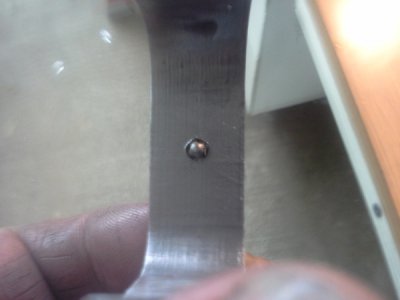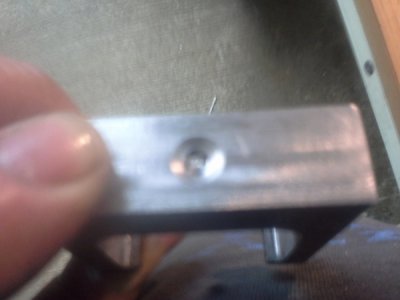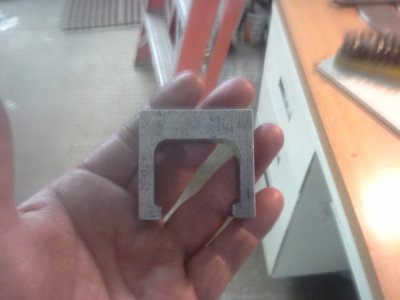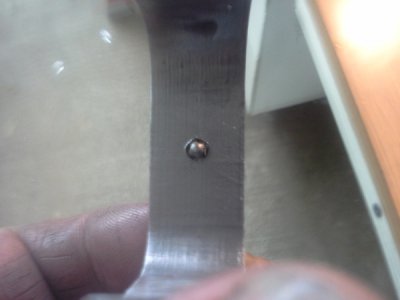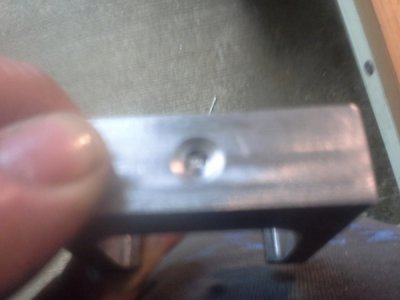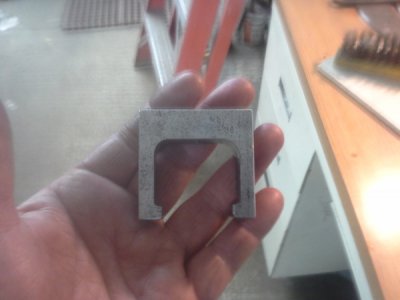I broke a tap off in a part I have been working on for a couple evenings.It broke just as it was crowning the other end of the hole.I picked at alittle and chalked it up to the school of hard knocks.Should have drilled the hole a little bigger.Anyway more practice on layout and back to the mill.This time I will drill to nearest fractional size.Its not a load bearing fastener.I am making a hold down for a v-block.:angry::angry:
-
Welcome back Guest! Did you know you can mentor other members here at H-M? If not, please check out our Relaunch of Hobby Machinist Mentoring Program!
You are using an out of date browser. It may not display this or other websites correctly.
You should upgrade or use an alternative browser.
You should upgrade or use an alternative browser.
Broke a Tap
- Thread starter gredpe3
- Start date
- Joined
- Apr 7, 2014
- Messages
- 343
I broke a tap off in a part I have been working on for a couple evenings.It broke just as it was crowning the other end of the hole.I picked at alittle and chalked it up to the school of hard knocks.Should have drilled the hole a little bigger.Anyway more practice on layout and back to the mill.This time I will drill to nearest fractional size.Its not a load bearing fastener.I am making a hold down for a v-block.:angry::angry:
do you have a photo? what material?
a broken tap sucks, but it isn't the end of the world.
There are ways to get the tap out.
chris
- Joined
- Feb 8, 2014
- Messages
- 11,176
On small holes, I would use a Dremel and a carbide burr. It takes some time, but it works. Sometimes it's possible to grind a couple of small dowel pins to fit down the flutes of the tap, then grab them with Vice-Grips and try to twist the broken tap out. The problem with that is that many times, the tap ''explodes'' in the hole, so it wedges in the hole. There are also some chemical methods of removing taps depending on the materials involved.
- Joined
- Jul 26, 2011
- Messages
- 4,142
As I have mentioned before,I have a few sets of Chinese made carbide end mills,from about 1/32" to about 1/8" in assorted steps. They are probably metric. I have used them several times to mill out broken HSS taps when I was the toolmaker in Williamsburg museum. Others would bring their broken taps in gun springs(or other stuff they SHOULD have tapped before hardening!!) I ran the Bridgeport as fast as it would go. With the assorted carbide milling cutters,I could find a size that would mill out the tap,leaving the threads perfectly intact.
I used to buy these sets at a gun show from a guy who sold import tools. They were $10.00 for a box of 10 small carbide end mills. They are great little taps. I wish I could find more of these sets. They are well coated with TIN.
I used to buy these sets at a gun show from a guy who sold import tools. They were $10.00 for a box of 10 small carbide end mills. They are great little taps. I wish I could find more of these sets. They are well coated with TIN.
- Joined
- Jul 9, 2014
- Messages
- 613
I'd try get a decent socket set screwdriver bit & the brace or "T" bar set up from the socket set , then grind a perfect screwdriver slot in the unbroken end of the tap then ,
Gently heat the whole item to boiling point , slip it in a vice that you can work at from above whilst using the socket set screw driver set up ,give it a squirt of oil and use the screw driver and a socket set to gently but with firm pressure from above at the vertical try and unscrew the tap . You may find that the different coefficients of linear expansion of the block and the tap are enough to make a tiny workable clearance to start movement .
If there is no movement heat the whole block to a nice cherry red to let it cool with out doing anything to it to anneal the metals . Now try and unscrew it as above then using a made up mild steel drill guide clamped to item dot punch the tap once only , now drill it out using the drill guide jig & a cobalt drill then re -temper or case harden the block AFTER you have completed the tapping .
You could also consider laying a lump of MS over the protruding tap end whilst it is on a solid surface and giving ONE ( only one ) fair smack on the M .S. with a one pound hammer ..it may move the tap back a smidgeon ..just enough to enable you to do the unscrewing as indicated above . I'd do it before I cut the screw slot to reduce the chances of the tap shearing at the end around the slot .
Thinking a bit laterally about some of the things I've done to remove broken /sheared cylinder head bolts etc . ...
Having cut the perfect screw slot in the tap end with a Dremmel type grinding blade you could use the drill press chuck to hold the screw driver bit at perfect right angles to the axis and use the operating lever of the press to apply pressure to keep the bit in the slot whilst turning the chuck gently but firmly by hand or very carefully with a pipe wrench etc. on the chuck part that is not moved when you use the chuck key .
The secret of it all is a continuous gently downward force applied to a well fitting quality Diamond coated cobalt or titanium screw driver tip that fits perfectly in the cut slot , turned with a constant smooth rotational pressure/ movement .
Gently heat the whole item to boiling point , slip it in a vice that you can work at from above whilst using the socket set screw driver set up ,give it a squirt of oil and use the screw driver and a socket set to gently but with firm pressure from above at the vertical try and unscrew the tap . You may find that the different coefficients of linear expansion of the block and the tap are enough to make a tiny workable clearance to start movement .
If there is no movement heat the whole block to a nice cherry red to let it cool with out doing anything to it to anneal the metals . Now try and unscrew it as above then using a made up mild steel drill guide clamped to item dot punch the tap once only , now drill it out using the drill guide jig & a cobalt drill then re -temper or case harden the block AFTER you have completed the tapping .
You could also consider laying a lump of MS over the protruding tap end whilst it is on a solid surface and giving ONE ( only one ) fair smack on the M .S. with a one pound hammer ..it may move the tap back a smidgeon ..just enough to enable you to do the unscrewing as indicated above . I'd do it before I cut the screw slot to reduce the chances of the tap shearing at the end around the slot .
Thinking a bit laterally about some of the things I've done to remove broken /sheared cylinder head bolts etc . ...
Having cut the perfect screw slot in the tap end with a Dremmel type grinding blade you could use the drill press chuck to hold the screw driver bit at perfect right angles to the axis and use the operating lever of the press to apply pressure to keep the bit in the slot whilst turning the chuck gently but firmly by hand or very carefully with a pipe wrench etc. on the chuck part that is not moved when you use the chuck key .
The secret of it all is a continuous gently downward force applied to a well fitting quality Diamond coated cobalt or titanium screw driver tip that fits perfectly in the cut slot , turned with a constant smooth rotational pressure/ movement .
Last edited:
- Joined
- Aug 22, 2012
- Messages
- 4,271
you need one of these. http://www.homemodelenginemachinist.com/downloads/files/Easy_Spark_Eroder.pdf
The circuit is very simple but works well.
I lashed up mine using wood for the slides, square steel tube for the post, an old chuck from a broken drill and powered it from the transformer of an old welder giving 40V to drive it.
The down feed was a bit of all thread with a handle. In practice the vibration from its operation self feeds the head.
Some very rough pics here of mine (from post 19)and more links further down
http://www.hobby-machinist.com/showthread.php/10122-tumbler-reverse?highlight=savarin
The circuit is very simple but works well.
I lashed up mine using wood for the slides, square steel tube for the post, an old chuck from a broken drill and powered it from the transformer of an old welder giving 40V to drive it.
The down feed was a bit of all thread with a handle. In practice the vibration from its operation self feeds the head.
Some very rough pics here of mine (from post 19)and more links further down
http://www.hobby-machinist.com/showthread.php/10122-tumbler-reverse?highlight=savarin

